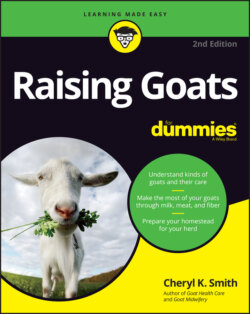Читать книгу Raising Goats For Dummies - Cheryl K. Smith - Страница 38
The digestive system
ОглавлениеGoats are ruminants, which means that they have four stomach compartments and part of their digestive process includes regurgitating partially digested food and chewing it, called ruminating. This kind of digestive system needs a plant-based diet.
Understanding a goat’s digestive system and how it works helps you keep your herd healthy or identify potential problems.
The goat stomach consists of three forestomachs — the rumen, reticulum, and omasum — and a true stomach, the abomasum. (See Figure 2-2.) The forestomachs are responsible for grinding and digesting hay, with the help of bacteria. The last compartment, the abomasum, is similar to the human stomach and digests most proteins, fats, and carbohydrates.
FIGURE 2-2: The parts of a goat’s digestive system.
Each stomach compartment has a different function, and they all work together:
The rumen is the largest of the forestomachs, with a 1- to 2-gallon capacity. It is a large fermentation vat that has bacteria living in it. These microorganisms break down roughage, such as hay. Then the goat regurgitates the partially broken-down material, chews it as a cud, and then swallows it.This repetitive process, rumination, creates methane gas as a byproduct. Methane is the cause of the strong-smelling belches that you can expect from a goat with a healthy rumen. A goat that can’t belch has bloat. (See Chapter 11 for signs and treatment of bloat.) The rumen action also creates heat, much like a compost pile, which helps a goat stay warm.
The reticulum is in front of and below the rumen, near the liver; the reticulum and the rumen work together to initially break down the food. Rumen contractions push the smaller particles of partially digested food into the rumen and heavier pieces into the reticulum. Then the reticulum contracts and sends the partially digested food into the mouth as a cud for chewing.This process continues until the pieces are small enough to pass through to the omasum. The reticulum also catches harmful things, such as wire or nails, that a goat accidentally swallows (see Chapter 11).
After fermentation and rumination break down the roughage, it moves through the reticulum to the omasum, where enzymes further digest it. The omasum has long tissue folds whose function is to help remove fluid and decrease the size of food particles that come out of the rumen.
The abomasum is the only compartment that produces digestive enzymes. It completes the next step in the digestive process of food that forestomachs partially broke down. The abomasum handles the primary digestion of grain and milk, which don’t need rumen bacteria to be digested. The products of this part of digestion pass into the intestine for final breakdown, separating waste products from usable fats and proteins.
